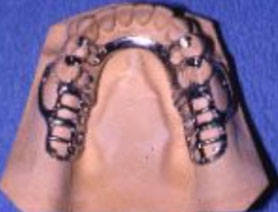- NEED HELP? CALL US NOW
- +919995411505
- [email protected]

1. The removable partial denture design should be finalized prior to
a. any emergency treatment.
b. any fixed prosthodontics treatment and preparation of rest seats
c. remove third molar
d. remove crown bridge
Ans: B
2. Function of the teeth is /are
a. Mastication
b. Phonation
c. Esthetic
d. All are correct
Ans: D
3. The Kennedy Classification for this cast is
a. Class III mod I
b. class III mod II
c. class III
d. class III mod III
in the picture a mandibular with missing teeth: #36,35,46
Ans: A
KENNEDY CLASSIFICATION
• Class I: Bilateral edentulous areas located posterior to the natural teeth.
• Class II: A unilateral edentulous area posterior to the remaining natural teeth.
• Class III: Unilateral edentulous area with natural teeth remaining both ant and post to it.
• Class IV: A single, but bilateral (crossing the midline), edentulous area located anterior to the remaining natural teeth
Edentulous areas other than those determining the basic classes were designated as modification spaces
4. The basic movement of mandible
a. hinge movement
b. translatory movement
c. lateral movement
d. hinge , lateral and translatory movement
Ans: D
MANDIBULAR MOVEMENTS
Mandible performs habitual and border movements opening and closing movements protrusive and lateral movements And stopping positions along these movements centric occlusion, centric relation, protrusive border position, right and left lateral border positions, and a rest position.
5. Which one of the following classes of RPD, never has an axis of rotation?
a. class I
b. class II
c. class III
d. class IV
Ans: C
Based on the fact that Kennedy class III RPD has smaller denture rotating movements, it can be assumed that the masticatory load could be distributed to the most posterior molars in Kennedy class III RPD, compared to bilateral distal extension RPD of Kennedy class I, II
6. Shape of rest for canine is
a) Full moon shaped
b) Half moon shaped
c)Half pear-shaped
d) None of the above
Ans. B
7. Indication of Removable Partial Denture
a. Large edentulous space, deep undercut of abutment, not posterior of abutment
b. Periodontitis of abutment, esthetic for posterior tooth, not posterior of abutment
c. Large edentulous space, not posterior of abutment, periodontitis of abutment
d. Deep undercut of abutment, periodontitis of abutment, not posterior of abutment
Ans: C
8. in reference to the partially edentulous arch and accompanying framework shown—what is the Kennedy classification?

a) Class I, Modification 0
b) Class II, Modification 1
c) Class III, Modification 0
d) Class IV, Modification 0
Ans: A
According to the Kennedy Classification, the partially edentulous arch shown is a Class I, Modification 0. There are bilateral posterior extension areas with no other modification (edentulous) space (s) present.
9. Class IV Kennedy classification is
a) A unilateral edentulous area posterior to the remaining natural teeth.
b) A single, but bilateral (crossing the midline), edentulous area located anterior to the remaining natural teeth
c) Unilateral edentulous area with natural teeth remaining both ant and post to it.
d) Bilateral edentulous areas located posterior to the natural teeth.
Ans: B
10. Bilateral edentulous areas located posterior to the natural teeth can be classified as Kennedy’s
a) Class I
b) Class II
c) Class III
d) Class IV
Ans: A




